Roy Knabenshue had become an instant celebrity when he piloted the
dirigible 'California Arrow' at the 1904 World’s Fair in Saint Louis, the
first successful circuitous flight of an airship in the United States.
The
sudden glory was unexpected, he’d volunteered to fly the dirigible after
its inventor, “Captain” Thomas Baldwin (whom he’d met at the fair)
proved to be too heavy for the airship to lift off with. Knabenshue‘s
combination of slight stature, experience sailing his father’s yacht, and
an interest in the possibility of flight was an irresistible combination
for the frustrated Baldwin. He hired the 29 year old Knabenshue on the
spot. Their first attempt at flight nearly ended in disaster, the 'Arrow’s'
engine died suddenly ten minutes into the flight. Knabenshue and the 'Arrow'
drifted for almost ninety minutes, clearing the Mississippi River before
landing in a cornfield in Illinois. A second attempt, on October 31, 1904
was entirely successful. Knabenshue landed the 'Arrow' at approximately the
same place from which he’d taken off. He became an instant hero, the first
American it was widely believed, to make a controlled flight.
Knabenshue went back to Ohio with enough practical knowledge
to
construct his own dirigible. Basing his design on that of the 'Arrow',
Knabenshue built a craft of wood, rope, Japanese silk, a ten horsepower
gasoline engine, and hydrogen. The following summer he took his airship,
the 'Toledo Number Two', hired a manager and a crew, and set off across
America in what he termed “a scientific exhibition”.
The Brockton Fair
was a yearly highlight in the shoe manufacturing city of
40,000. Just as Brockton had become industrialized, the Fair had become
less of an agricultural event and more like a carnival, complete with a
midway, rides, and daily trotter races. The Fair brought together an
eclectic mix of working class and society elites. The Vanderbilts attended
the Fair along with shoe factory employees and Massachusetts Governor
William L. Douglas, who had made his fortune as owner of one of Brockton’s
shoe factories and lived just a few blocks from the Fairgrounds. Cattle
shows were held just up the track from the sideshows on Fakirs’ Row.
Trolley
riders walked side by side with those who had left their
transportation in the automobile enclosure. And the King of the Air
appeared on the same bill as Herbert and his Wonderful Herd of Performing
Dogs and Juan Puente, the Amazing Barehanded Juggler.
Knabenshue’s
final appearance at the Fair, in 1907, was in many ways
anticlimactic. By now, controlled flight was old news and Fair attendance
was down. Knabenshue and his party didn’t arrive at the Fair until the
night before it opened. The dirigibles now had competition from heavier
than air ships; the Wright brothers had patented their invention by now
and
were trying to sell it to the US Army, and the great French aerialist
Santos Dumont had successfully flown an aeroplane of his own design in
France. Knabenshue told reporters that this would be his final appearance
at the Fair, the aggravation of touring with the huge airship, coupled
with the barbs of criticism when he couldn’t fly, and only modest profits
when he could, had persuaded this that it was time to give up touring.
He
set his sights on a $50,000 prize offered for the first successful aerial
crossing of the English Channel. In his final interviews with the Brockton
press, he now expressed confidence in the commercial future of the airship, he himself had built a successful three person passenger airship carriage
since his last visit to Brockton, but it had unfortunately been destroyed
in a fire at the Iowa State Fair, so he would be unable to take up any
passengers during his final appearance in Brockton.
Bad weather and bad timing marred Knabenshue’s last visit to the Fair.
Cold, rainy weather allowed only three flights, down from nine the year
before. Knabenshue had hoped to mark Governor’s Day at the Fair by landing
the airship directly in front of new Massachusetts Governor Curtis Guild,
but by the time he touched down the Governor had already moved on.
The last flight was on the fourth and final day of the Fair. Knabenshue
flew his craft beyond the Fairgrounds to the center of Brockton, where he
circled City Hall a few times before heading back. As he made his approach
to land near his tent, he tried to negotiate between two large pine trees
standing about 100 yards apart. As he began the maneuver a sudden gust
of
wind hit him sidelong. Fearing that he was going to be pushed into one
of
the trees, he quickly tacked, altering his course so that instead of coming
down between the trees, he would go around them, passing between the tree
on the right and the roof of one of the cattle barns. As he did so, the
wind caught him again, pushing the ship toward the barn, where the
varnished silk air bag caught on the corner of the cupola of the building,
creating a foot and a half long gash in the underside of the bag.
The airship was caught on the roof of the barn. Luckily, he had been just
yards from his sheltering tent where his assistants stood waiting. They
hurried beneath him and caught the rope he tossed down, holding it as the
pilot worked to dislodge his ship. Once that was done, they quickly pulled
both the sailor and the ship back to earth.
Knabenshue reported that the damage would be quickly repaired, that it
was
just a matter of closing the tear and shellacking over it and that both
he
and his airship would be ready to fly in time for the Danbury Connecticut
Fair the following week. As he left the tent after inspecting the damage
to the bag, Knabenshue was consoled by a passing stranger. At least, the
stranger said, Knabenshue hadn’t been killed in the accident. “Oh yes,”
Knabenshue replied quickly. “I shall never lose my life in an airship.”
He was right about that.
Knabenshue never did succeed in flying an airship over the English Channel
(that feat would instead be achieved by Louis Beriot with an aeroplane in
1909). He rebuilt his three passenger airship and eventually did use it
to
fly passengers commercially, briefly running a commuter airship service
in
California in 1912. He learned to fly an airplane and was hired as manager
of the Wright Brothers’ Traveling Exhibition team. He went on to build
observation balloons and later worked for the US Park Service. As an old
man, he still talked about the commercial potential of airships. Roy
Knabenshue died on March 6, 1960 at the age of 82 and was admitted to the
National Aviation Hall of Fame five years later...
Knabenshue had hoped to leave Brockton on a triumphant note, flying from
the Fairgrounds to the freight yard, leaving Brocktonians with a final
parting image of him soaring triumphantly into the future. Unfortunately,
the ripped balloon made this memorable departure impossible, and the
airship left Brockton by traveling disassembled on two horse drawn vans
to
the freight yard, from whence it made its final, ignominious departure.
"Sky Pilot"
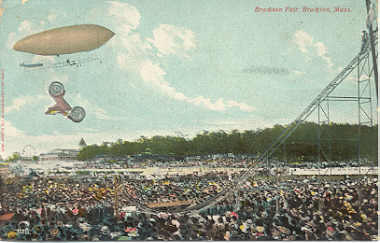
The Wright brothers made their first successful flight in December of
1903. They then proceeded to keep this fact more or less a secret for the
next few years while they perfected their craft and waited to get their
invention patented. Hot air balloons had been in existence for over a
hundred years by then, but they were at the mercy of the wind and could
not
be steered. So when L. Roy Knabenshue announced that he’d be bringing his
airship 'Toledo The Second' a steerable dirigible of his own construction
to the 1905 Brockton Fair, the entire greater Brockton Massachusetts area
went wild with excitement.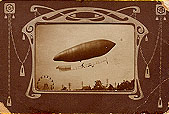 The 'Toledo Number Two' arrived in Brockton by train, carefully supervised by
Roy
Knabenshue himself, along with his manager and promoter, the operator of
the Toledo Baseball Association, Charles Stobel. In all, Knabenshue
traveled with an entourage of four assistants, including Monsieur Eugene
Godart, the “scientific hydrogen gas expert.” Having Monsieur Godart among
the crew lent a particular credibility to their endeavors. Prior to his
Saint Louis flight the years before, the best known successful aerialist
had been Alberto Santos Dumont, a Brazilian born resident of France who
had
made a series of widely publicized flights, including a successful circling
of the Eiffel tower in a dirigible in October of 1901.
From the time
the airship arrived in Brockton two days before the October
4th opening of the fair, the 'Toledo' and its pilot were the focus of much
speculation. Men who bore a resemblance to the picture of Knabenshue which
appeared on the front pages of the two local newspapers, the Brockton Times
and the Brockton Enterprise, were approached on the street to be asked if
they were the famous airship pilot. A huge tent, of Knabenshue’s own
design, was erected on the fairgrounds to the east of the exhibition hall
and south of the automobile enclosure. Knabenshue himself checked into
the
nearby Belmont Hotel, giving interviews to the press on the upcoming
flight.
It was, he insisted in his interviews, not a novelty act, but a
“scientific exposition”. There was no hope of any commercial future for
airships, he said. The airship could not fly in rough weather nor when
the
wind measured more than eight miles an hour. The perfect conditions, he
explained, were a fair day with five mile an hour winds. He could not,
he
regretted, take up any passengers in his airship. It was strictly a one
man
conveyance, and furthermore, he told the press with great authority, that
even though he himself had conquered the air, the uncertainties of weather,
wind currents and the fragility of the craft itself meant that there was
no
commercial future in manned flight and that all would be wise to avoid
investing in such schemes.
The 'Toledo Number Two' arrived in Brockton by train, carefully supervised by
Roy
Knabenshue himself, along with his manager and promoter, the operator of
the Toledo Baseball Association, Charles Stobel. In all, Knabenshue
traveled with an entourage of four assistants, including Monsieur Eugene
Godart, the “scientific hydrogen gas expert.” Having Monsieur Godart among
the crew lent a particular credibility to their endeavors. Prior to his
Saint Louis flight the years before, the best known successful aerialist
had been Alberto Santos Dumont, a Brazilian born resident of France who
had
made a series of widely publicized flights, including a successful circling
of the Eiffel tower in a dirigible in October of 1901.
From the time
the airship arrived in Brockton two days before the October
4th opening of the fair, the 'Toledo' and its pilot were the focus of much
speculation. Men who bore a resemblance to the picture of Knabenshue which
appeared on the front pages of the two local newspapers, the Brockton Times
and the Brockton Enterprise, were approached on the street to be asked if
they were the famous airship pilot. A huge tent, of Knabenshue’s own
design, was erected on the fairgrounds to the east of the exhibition hall
and south of the automobile enclosure. Knabenshue himself checked into
the
nearby Belmont Hotel, giving interviews to the press on the upcoming
flight.
It was, he insisted in his interviews, not a novelty act, but a
“scientific exposition”. There was no hope of any commercial future for
airships, he said. The airship could not fly in rough weather nor when
the
wind measured more than eight miles an hour. The perfect conditions, he
explained, were a fair day with five mile an hour winds. He could not,
he
regretted, take up any passengers in his airship. It was strictly a one
man
conveyance, and furthermore, he told the press with great authority, that
even though he himself had conquered the air, the uncertainties of weather,
wind currents and the fragility of the craft itself meant that there was
no
commercial future in manned flight and that all would be wise to avoid
investing in such schemes.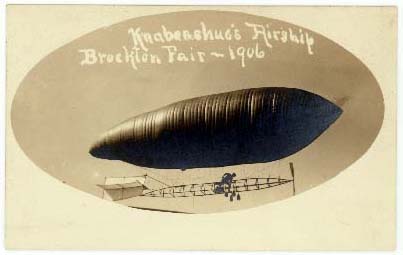 The first flight over Brockton was unannounced. Sometime around 8 o’clock
on October 4, before the grounds were officially opened for the first day
of festivities, the giant canvas tent was opened and the huge airship was
guided out to rest upon a row of sawhorses, keeping it just high enough
for
the propellor to clear the ground. People came running from all over the
grounds, thrilled to be present at the unscheduled event, an estimated
2,000 of them watched as the ropes were tested, the motors tried, and the
ballasting sandbags removed. The crowd grumbled with impatience as the
young Knabenshue, chewing a large wad of gum, mounted the triangular wooden
frame and made the final adjustments. The craft itself was quite primitive.
In order to take off, he had to sit in the back of the craft so that his
bodyweight acted as ballast and kept the stern weighted down and the nose
pointed skyward. Once he reached the optimal height, he’d scramble forward
along the frame to level the airship’s flight, steering by means of pulling
on ropes to control the rudder from the center of the craft.
At 8:50, everything seemed ready. Knabenshue shouted “Let go!” over the
hum of the engine and his assistants released their hold on the craft,
which obligingly rose to the cheers of the crowd.
The cheers quickly turned to cries of horror. In a moment that was
horrifyingly reminiscent of the near disaster at the World Fair, the engine
suddenly choked, causing the propellor to stop spinning. Without his
engine or propellor and in a nose-up position, Knabenshue was unable to
steer the ship. The 'Toledo Number Two' traveled 30 yards in 30 seconds, right
toward the roof of one of the cattle barns. Knabenshue managed to clear
the roof, but not the gilt-balled iron flagpole that topped it. The
netting that surrounded the end of the cigar-shaped bag of hydrogen caught
on the pole, tearing away with a rip as the fast thinking pilot stopped
the
engine and shouted for help. His team of assistants were beneath him in
seconds, waiting to catch the end of a rope that he tossed down to them.
They pulled him down to safety and hurried the 'Toledo' back into the tent,
leaving the crowd with nothing but the bent flag pole atop the roof to look
at and shake their heads over.
Knabenshue had been very lucky. Had the flagpole not been topped with
the
gilt ball, the bag itself might have been punctured, causing him serious
injury or death, not the mention the damage to the machine that was his
livelihood. As it was, only the netting had been ripped, and that was
easily reparable. Of greater concern was the engine. An announcement
was
made to the crowd that Mr. Knabenshue and his team would undertake to
repair the damage and attempt to make the two flights that had been
scheduled for that day. Several times that day, rumors swept the grounds
that a flight was imminent, sending crowds of people to the canvas hangar.
When it was announced, as dusk fell, that it was too windy for Knabenshue
to fly, shouts of “Fake!” went up and the crowd pressed against the ropes
surrounding the tent. The four Brockton Police Officers present quickly
called for reinforcement, and it was only the presence of nineteen of
Brockton’s finest that kept the crowd from surging into the tent bent on
mayhem.
Knabenshue never made another attempt at flight during the 1905 fair.
He
blamed the weather conditions rather than a mechanical failure. At the
fair’s end, he packed up his airship and sent it by train back to 'Toledo'.
He had been the costliest attraction ever to appear at the fair, and also
the most disappointing.
The first flight over Brockton was unannounced. Sometime around 8 o’clock
on October 4, before the grounds were officially opened for the first day
of festivities, the giant canvas tent was opened and the huge airship was
guided out to rest upon a row of sawhorses, keeping it just high enough
for
the propellor to clear the ground. People came running from all over the
grounds, thrilled to be present at the unscheduled event, an estimated
2,000 of them watched as the ropes were tested, the motors tried, and the
ballasting sandbags removed. The crowd grumbled with impatience as the
young Knabenshue, chewing a large wad of gum, mounted the triangular wooden
frame and made the final adjustments. The craft itself was quite primitive.
In order to take off, he had to sit in the back of the craft so that his
bodyweight acted as ballast and kept the stern weighted down and the nose
pointed skyward. Once he reached the optimal height, he’d scramble forward
along the frame to level the airship’s flight, steering by means of pulling
on ropes to control the rudder from the center of the craft.
At 8:50, everything seemed ready. Knabenshue shouted “Let go!” over the
hum of the engine and his assistants released their hold on the craft,
which obligingly rose to the cheers of the crowd.
The cheers quickly turned to cries of horror. In a moment that was
horrifyingly reminiscent of the near disaster at the World Fair, the engine
suddenly choked, causing the propellor to stop spinning. Without his
engine or propellor and in a nose-up position, Knabenshue was unable to
steer the ship. The 'Toledo Number Two' traveled 30 yards in 30 seconds, right
toward the roof of one of the cattle barns. Knabenshue managed to clear
the roof, but not the gilt-balled iron flagpole that topped it. The
netting that surrounded the end of the cigar-shaped bag of hydrogen caught
on the pole, tearing away with a rip as the fast thinking pilot stopped
the
engine and shouted for help. His team of assistants were beneath him in
seconds, waiting to catch the end of a rope that he tossed down to them.
They pulled him down to safety and hurried the 'Toledo' back into the tent,
leaving the crowd with nothing but the bent flag pole atop the roof to look
at and shake their heads over.
Knabenshue had been very lucky. Had the flagpole not been topped with
the
gilt ball, the bag itself might have been punctured, causing him serious
injury or death, not the mention the damage to the machine that was his
livelihood. As it was, only the netting had been ripped, and that was
easily reparable. Of greater concern was the engine. An announcement
was
made to the crowd that Mr. Knabenshue and his team would undertake to
repair the damage and attempt to make the two flights that had been
scheduled for that day. Several times that day, rumors swept the grounds
that a flight was imminent, sending crowds of people to the canvas hangar.
When it was announced, as dusk fell, that it was too windy for Knabenshue
to fly, shouts of “Fake!” went up and the crowd pressed against the ropes
surrounding the tent. The four Brockton Police Officers present quickly
called for reinforcement, and it was only the presence of nineteen of
Brockton’s finest that kept the crowd from surging into the tent bent on
mayhem.
Knabenshue never made another attempt at flight during the 1905 fair.
He
blamed the weather conditions rather than a mechanical failure. At the
fair’s end, he packed up his airship and sent it by train back to 'Toledo'.
He had been the costliest attraction ever to appear at the fair, and also
the most disappointing.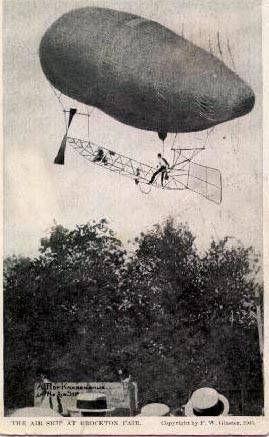 It’s easy to imagine the reluctance with which the Fair management signed
Knabenshue for a second appearance the following year. The ire of the
crowd at the dismal failure the year before had been reflected upon the
fair’s management, and accusations of fraud fell their way as well.
Knabenshue was still smarting over his failure of 1905. He publicly went
on record as saying that the Fair’s management was among “the whitest” he’d
ever had the pleasure of dealing with, and furthermore, he would take no
payment for his appearance at the 1906 Fair unless he made a successful
flight. He publicly vowed that this time, when he left “the people of
Brockton would be perfectly satisfied.” It was enough, he and the 'Toledo'
were booked to appear.
He made good on his promise. On the first morning of the fair, he made
a
five minute flight over the grounds that was, by all accounts, “perfect”.
He flew into the wind and with the wind, both over the fairgrounds and the
city beyond. He navigated by following the streets below, sailing along
Belmont Street until he came in sight of City Hall, which he circled
several times before going back along West Elm Street, turning when he came
to Governor Douglas’s brownstone house at the corner of Ash St. and West
Elm and heading back to the Fairgrounds where he landed in the same place
from which he started. He ended his first flight by pointing at the
still-bent flag pole that topped the cattle barn, jubilantly exclaiming
“I
showed them!”
The young pilot made eight more successful flights during the Fair’s four
day run. Literally thousands of people below saw him and believed in the
reality of controlled flight. He may have billed his work as a scientific
exhibition, but he was canny enough to recognize the value of good
showmanship. He’d circle the race track in front of the grandstand, tip
his hat to the crowd, and wave the American Flag from his perch high above.
The crowd loved it. One of the acts, Martland’s Band, added to the
atmosphere by playing, “Up in a Balloon, Boys” when they saw the airship
overhead, never missing a note as they watched the flights from the stage
much to the delight of the crowd. The flights were, as the Brockton
Enterprise declared it in that night’s headline, “perfection.”
It’s easy to imagine the reluctance with which the Fair management signed
Knabenshue for a second appearance the following year. The ire of the
crowd at the dismal failure the year before had been reflected upon the
fair’s management, and accusations of fraud fell their way as well.
Knabenshue was still smarting over his failure of 1905. He publicly went
on record as saying that the Fair’s management was among “the whitest” he’d
ever had the pleasure of dealing with, and furthermore, he would take no
payment for his appearance at the 1906 Fair unless he made a successful
flight. He publicly vowed that this time, when he left “the people of
Brockton would be perfectly satisfied.” It was enough, he and the 'Toledo'
were booked to appear.
He made good on his promise. On the first morning of the fair, he made
a
five minute flight over the grounds that was, by all accounts, “perfect”.
He flew into the wind and with the wind, both over the fairgrounds and the
city beyond. He navigated by following the streets below, sailing along
Belmont Street until he came in sight of City Hall, which he circled
several times before going back along West Elm Street, turning when he came
to Governor Douglas’s brownstone house at the corner of Ash St. and West
Elm and heading back to the Fairgrounds where he landed in the same place
from which he started. He ended his first flight by pointing at the
still-bent flag pole that topped the cattle barn, jubilantly exclaiming
“I
showed them!”
The young pilot made eight more successful flights during the Fair’s four
day run. Literally thousands of people below saw him and believed in the
reality of controlled flight. He may have billed his work as a scientific
exhibition, but he was canny enough to recognize the value of good
showmanship. He’d circle the race track in front of the grandstand, tip
his hat to the crowd, and wave the American Flag from his perch high above.
The crowd loved it. One of the acts, Martland’s Band, added to the
atmosphere by playing, “Up in a Balloon, Boys” when they saw the airship
overhead, never missing a note as they watched the flights from the stage
much to the delight of the crowd. The flights were, as the Brockton
Enterprise declared it in that night’s headline, “perfection.”
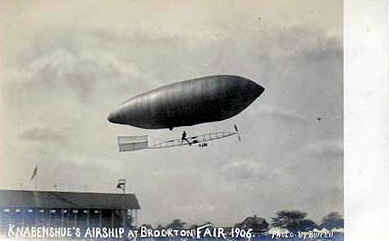
by Mary Gorman